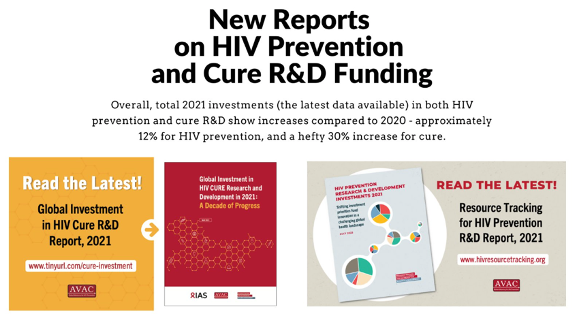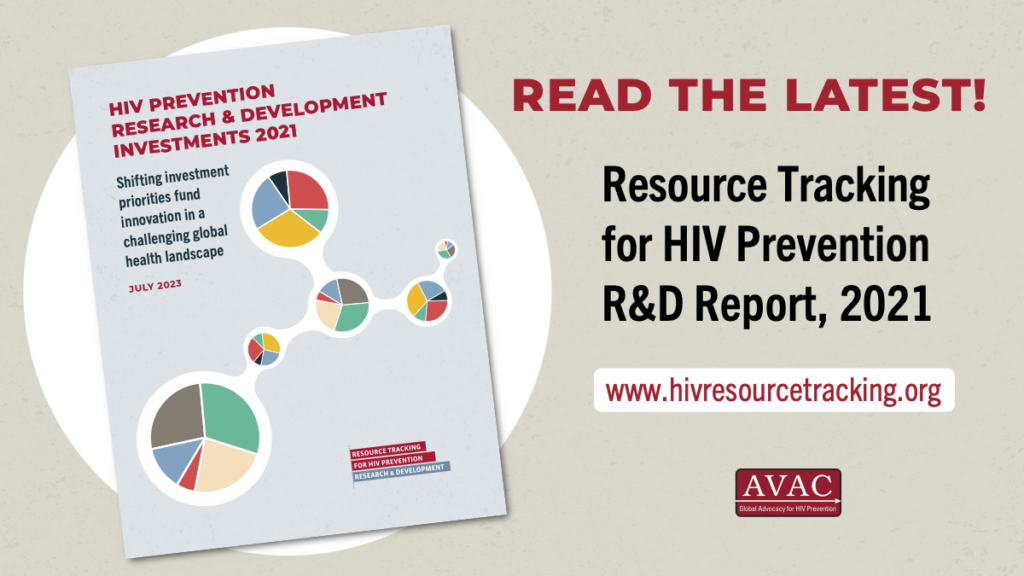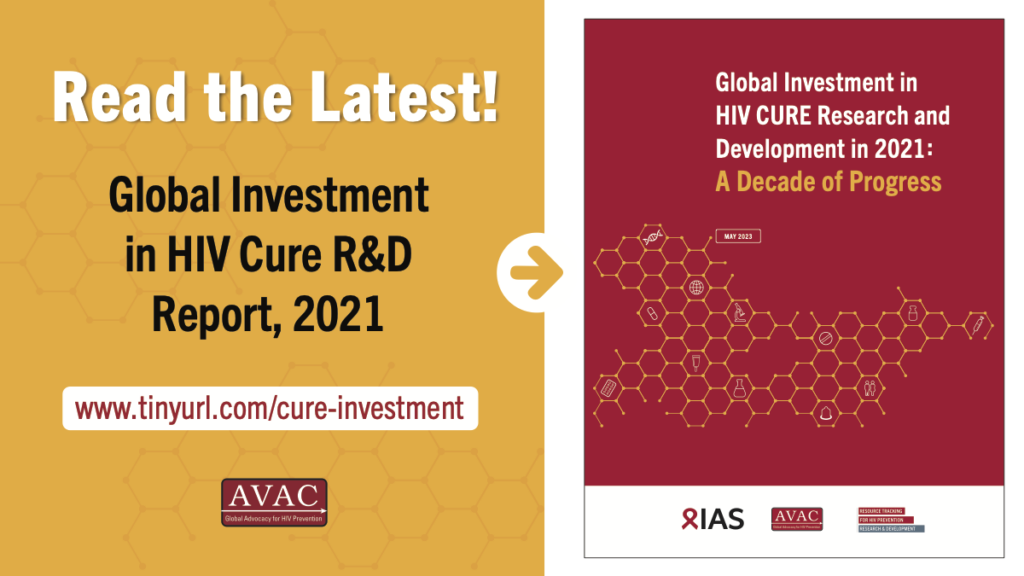Late July saw two nearly simultaneous conferences on the future of research and advocacy for HIV and sexually transmitted infections (STIs). IAS 2023 in Brisbane and the 2023 STI and HIV World Congress (also known as ISSTDR) in Chicago are landmark annual events. Both conferences bring together civil society, advocates, policy makers, donors and scientists to share the latest scientific findings and discuss where advocacy is needed to both advance research and ensure equity informs every aspect of the development process, from basic science to delivering new interventions. There may be two gatherings, but it’s one vital conversation. HIV and STIs are inextricably linked, affecting the same communities, who face the same barriers to care and prevention against these health threats. At AVAC, we see the links and we are making the connections. Below we offer highlights from these two all-important world gatherings, and check out our recent webinar linking these conversations, Tales from Two Cities: HIV and STI research highlights from Brisbane and Chicago.
AVAC at IAS
Taking prevention to the next level: Packaging PrEP with primary health care services as a pathway to achieving 2030 HIV prevention and universal health coverage goals
This satellite, co-sponsored by PATH, IAS, WHO and AVAC, put a spotlight on integrated, person-centered care, a central theme of the 2023 UNAIDS report launched at IAS 2023, The Path That Ends AIDS. UNAIDS reports that investing in person-centered priorities such as community-led services, integrating primary health care with HIV services, and a strong health workforce brings down incidence. And the pressure to scale up these approaches remains essential. According to the latest statistics in the report, only 42% of districts in African countries with very high HIV incidence are covered by prevention programs. Even more chilling, 4,000 adolescent girls and young women acquire HIV every week.A presentation in this session by former AVAC Fellow and CASPR partner Chilufya Kasanda from Zambia’s TALC put a face and a voice to this story. In Zambia, youth friendly services are scarce or non-existent, high rates of mental health issues are utterly neglected, and donors “flock to a few locations and leave out those who are most in need.” She said community advocates are too often dismissed as “people just making noise.” But, said Chilufyia, it’s young people who must receive support, their leadership must be nurtured and funded, and messages should be tailored just for them. “Young people need to know that pleasure, not only risk, is attached to sex. To get to pleasure, you need to be safe, that is the message.” Another AVAC Fellow, Elizabeth Onyango from Kenya’s Coast Sex Workers Alliance, called for accelerating access to the dapivirine vaginal ring. “Why is the ring not in our vaginas? Male condoms even come in different flavors! This is a women-first product and it needs more investment.”
Regaining lost ground for HIV prevention: Acting on lessons learned from oral PrEP scale-up new PrEP method mix
Prevention will fail if the HIV response remains narrowly focused on products. Oral PrEP has brought invaluable lessons we have yet to learn about how to get programming right so that effective products actually reach those who need them. As AVAC Executive Director Mitchell Warren said at the conference, reflecting on the status of PrEP uptake since FDA approval in 2012- “Only 4m global PrEP initiations in 12 years is an epic failure. Science has given us products that work, but our policies and programs have failed to meet the needs.”
This session featured presentations from AVAC on a package of tools called, Getting Rollout Right and the work of the Coalition to Accelerate Access to Long-Acting PrEP. Daniel Were of Jhpiego talked about lessons from the Jilinde project, Kenya’s ambitious program to deliver PrEP. The project adapted in real time to reach more people by recognizing that peer networks are essential, that stopping and starting PrEP is common, and that provider attitudes can be difficult to change. Daniel stressed the importance of focusing deeply on the people who need to use these products.
HIV Cure & Immunotherapy Forum
This preconference forum on HIV cure research featured innovative presentations tracking the progress toward an HIV cure. AVAC Senior Program Manager Jessica Salzwedel participated in a panel discussion on the importance of increasing diversity throughout HIV cure research from trial participants, to advocates, to researchers. The session also featured the release of a new resource on community preferred language for HIV cure.
bnAbs: From prevention to cure
This session covered the potential for research on broadly neutralizing antibodies (bNAbs) to inform strategies for both prevention and cure. AVAC partner Maureen Luba joined the panel discussion to applaud collaboration among the bNAb researchers working in prevention and cure, and she called for the same collaboration with communities. She said research budgets for community engagement should reflect the importance of community leadership right from the beginning, to ensure success in the future. Maureen added “thinking about cost and choice is the elephant in the room. The resource envelope for HIV prevention is not expanding enough. Countries will be asking ‘where will we get the money [for bNAbs].’ We have to think about cost effectiveness now.”
Next Gen HIV Prevention research: Clinical Trials in an era of highly effective standards of care
Investigators and advocates discussed innovative methods to test how new interventions compare to oral PrEP, and how to also make comparisons to HIV incidence in a given community. Models of community engagement were just as important in the conversation. Ntando Yola of APHA described robust programs that brought community members along as these complex new trial designs were developed. Investing in Good Participatory Practicemeans investing “in the platforms that equip and empower communities and advocates,” said Ntando. And for more on how trial design is evolving, check out AVAC’s Evolving Designs for HIV Prevention Trials.
AVAC at the STI & HIV World Congress
The STI Prevention Pipeline: Where Are We, and What Will It Take to Move Forward Faster?
This session on the state of the field offered updates on how STI prevalence and incidence rates are estimated, STI vaccine acceptance, STI test development, and information on the first US STI National Strategic Plan and Federal Implementation Plan. The session included discussions about advocacy priorities in each of these areas, with discussions continuing in the Advocacy Zone throughout the conference (see below). For more on the STI pipeline, check out the resource pages on STIwatch.org.
Setting Up a Remote/Home Testing STI Programme: A Practical Toolkit
This session explored the power of remote testing to curb STI acquisitions. Remote and home-testing brings many benefits. It’s convenient, overcomes barriers from stigma, offers privacy, reflects trauma-informed principles, and can overcome structural barriers. For the status of testing for several STIs go to the pathogen pages on STIwatch.org.
Symposium: New Vaccine Approaches to STI Prevention, STI Vaccine Acceptance, and Equity
This symposium shared progress on STI vaccine research and examined the question, “what factors could influence acceptance of STI vaccines and how do we ensure equitable access to these vaccines”. AVAC’s Dr. Alison Footman referenced the disparities in the COVID-19 vaccine and how vaccine access can differ due to income, health insurance, and region. Considerations around equity, access, vaccine hesitancy, vaccine confidence, and vaccine awareness must be confronted as an integrated part of the advocacy for STI vaccine development. This session provided a platform for framing these issues and developing an agenda for advocacy.
ISSTDR Advocacy Zone
AVAC hosted an Advocacy Zone at the conference, which bubbled with activity throughout the meeting. Advocates used this space to weigh in on questions and share perspectives on how the STI field can grow and how advocacy can equitably advance the field. Overall themes included the need to normalize sexual health, center pleasure in STI conversations and the urgency for increased funding to support STI prevention and research.
Spotlight on WHO News at Both Conferences
The WHO made headlines from Brisbane and Chicago, with major announcements and research findings that will be shaping global health for years to come.
U=U and Zero Risk
In a policy brief released at IAS 2023, the WHO directly affirmed zero risk of HIV transmission from people living with HIV who have an undetectable viral load using any WHO-approved test and who adhere to treatment. The brief, The role of HIV viral suppression in improving individual health and reducing transmission, also emphasizes the importance of expanding viral load testing, particularly in low and middle-income countries (LMICs) where access to testing falls far short of the need. The Lancet also published the WHO’s systematic review of the data behind this finding, championed since 2016 by the U=U campaign (undetectable=untransmittable).
A Call to Expand HIV Self-testing
Also from Brisbane, the WHO announced new HIV testing guidelines, calling for countries to expand use of HIV self-testing (HIVST) and to promote testing through social networks. In a July 22 press release, the WHO said, “These recommendations are issued at a moment of unique opportunity, when self-care and self-testing are increasingly being recognized as ways to increase access, efficiency, effectiveness and acceptability of health care across many different disease areas, including HIV.”
Surveillance of Mpox
The WHO presented their mpox surveillance data in Brisbane, building on findings reported at the Conference of Retroviruses and Opportunistic Infections that showed mpox severely impacts people living with HIV (PLHIV) who have a very low CD4 T-cell count. The WHO analysis draws from a larger set of data than was presented at CROI, and it found PLHIV with advanced immunosuppression were twice as likely to be hospitalized than people who are HIV-negative. See the aidsmap article for details.
Guidance on STIs
WHO called for better access to testing and diagnostic services at the STI & HIV World Congress. Its new guidance on testing and diagnostics includes: target product profiles (TPPs) for point-of-care tests for STIs, to diagnose syphilis, chlamydia trachomatis, neisseria gonorrhoeae and trichomonas vaginalis; and an updated edition of The diagnostic landscape for sexually transmitted infections featuring tools to scale up screening for syphilis, chlamydia, gonorrhoea, trichomoniasis, mycoplasma, herpes, and human papillomavirus (HPV) in LMICs. Earlier this year, the WHO approved its multi-year implementation strategy for HIV and STIs. For more information on the status of diagnostics and vaccines for STIs, go to STIwatch.org.
HIV Research Highlights
Women Want CAB for PrEP as a Choice in HIV Prevention
Researchers presented findings from the open label extension study of HPTN 084 studying injectable cabotegravir (CAB) for PrEP, among individuals born female. Among 2500 participants in seven African countries, nearly 78% chose injectable CAB and 22% preferred oral PrEP. And a related study, HPTN 084-01, also found CAB for PrEP was generally acceptable to a small study of cisgender adolescent women in a study conducted in South Africa, Uganda and Zimbabwe. 92% opted to continue use of CAB for PrEP in the open label extension. The study also found that engagement of parents or guardians could be pivotal, providing young women with the support they need to make choices with confidence. The HPTN’s Erica Hamilton said the study reinforces how much choice matters. “The efficacy of CAB for PrEP was reassuring, but some participants still preferred the oral tablet [which also has very high efficacy] for various reasons.”
New Data on VMMC Among Gay Men and Other Men Who Have Sex with Men (MSM)
A small but noteworthy study from eight cities in China showed VMMC offered protection against HIV transmission among MSM. Researchers say this first randomly controlled trial demonstrating efficacy among MSM should be followed up by larger trials.
Tracking the Inclusion of Transgender People in Research
The launch of AVAC and the Office of HIV/AIDS Network Coordination’s (HANC) Clinical Trial Scoring Tool, provided an initial analysis of the inclusion of transgender people in HIV research and a tool for tracking inclusion in the future. This tool generated great excitement during the poster session. The score card evaluating HIV research since 1991 found less than 1% of participants in 41 key HIV studies included transgender populations. “Dozens of attendees from Harare to Montreal to Hyderabad had questions and expressed interest in using the scorecard and applying it to other populations, too.”
Cure at IAS 2023
The “Chicago Patient” was first presented at CROI 2023 and is the first known case of rebound from a bone marrow transplant where the donor did NOT have a critical and rare mutation to what is called the CCR5 receptor, which is found on certain human immune cells. The individual decided to go back on therapy after two consecutive detectable viral loads. This case is interesting because it suggests that reservoir cells may persist even after extreme clearance measures that are part of a stem cell transplant.
The “Geneva Patient” is the potential sixth cure for HIV. This individual received a bone marrow transplant from a donor with wild type CCR5 — meaning they did not have natural immunity to HIV. The individual experienced severe graft vs. host disease, a complication where the new immune system attacks the host. No virus can be found 20 months off therapy using the most sensitive assays. The medication used to stop the effects of graft vs. host disease promotes latency, meaning the reservoir cells have a harder time reactivating. Researchers are excited about this case because it provides clues on the role of the immune system in clearance and potential pathways toward an HIV cure.
The 5 cases of pediatric control were presented by Gabriela Chaumet of University Kwa Zulu-Natal. This longitudinal study followed 281 mother-infant pairs with in utero transmission. The children were started on ART soon after birth and about 92% were exposed to ART in utero through the placenta. Five of the children, all male at birth, who were not adherent to ART were able to control the virus below detectable levels without therapy. However, Only 40% of the infant cohort was male. The study suggests the importance of the virus itself and indicates the need to further understand the impact sex & gender may have on future HIV cure strategies.
STI Research Highlights
GPP on the STI Map
From two different sessions in Chicago, a GPP champion and San Francisco’s Bridge HIV medical director Dr. Hyman Scott called out the power of Good Participatory Practice. In sessions on Biomedical Prevention for STIs and HIV and Addressing the HIV and STI Syndemic, Hyman’s presentations called for GPP to be implemented broadly. “I am really glad to see AVAC at this conference. We need GPP to hold us accountable,” said Hyman. CASPR partner Zinhle Sokhela of Wits RHI also gave background on GPP during the session Centering Equity, Inclusion and Diversity in STI/HIV Research and referenced a Cameroon and Cambodia PrEP trial that ended prematurely due to lack of effective community engagement. “The [GPP] guidelines help prevent misunderstanding and miscommunication among researchers and stakeholders.”
Antimicrobial Resistance and New Drugs in the Pipeline
Resistance to existing antibiotics for different STIs is spurring a hunt for alternative drugs. The conference presented encouraging early findings on new interventions for herpes simplex virus (HSV) and mycoplasma genitalium (M. genitalium), which cause urethritis and other diseases. A retrospective review of data from 165 patients found minocycline cured 2/3 of the resistant cases of M. genitalium. Phase II studies of pritelivir demonstrated superiority over the standard of care for resistant cases of HSV.
Women and DoxyPEP
Dr. Jenell Stewart presented additional data on the DoxyPEP study out of Kenya and found, from hair testing analyses, that 44% of women assigned to DoxyPEP may have not taken any of the medication. This could be one reason why DoxyPEP has not shown efficacy among women, from data that was previously presented at CROI 2023. Watch this space for more data coming out of the D-PEP Kenya study, including a look at the correlation between PrEP and DoxyPEP adherence, as well as conversations about future research of DoxyPEP in cisgender women.
The Promise of Self-Testing
A presentation by Preventx, a UK-based supplier of self-testing kits, featured their analysis that remote/home-testing led to the diagnosis of a similar number of STIs as those diagnosed in the clinic. Preventx shared that out of 2.2 million kits ordered over a given period of time, they saw a high rate of return, with 1.8 million kits returned.
This cross section of research, advocacy and innovation in STIs and HIV should be a call to action for all of us who see how equity and sexual health cannot be siloed.
P.S. In case you missed it, AVAC recently launched the latest HIV Prevention and Cure Resource Tracking Reports. Find all the details here.







